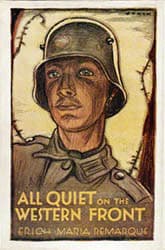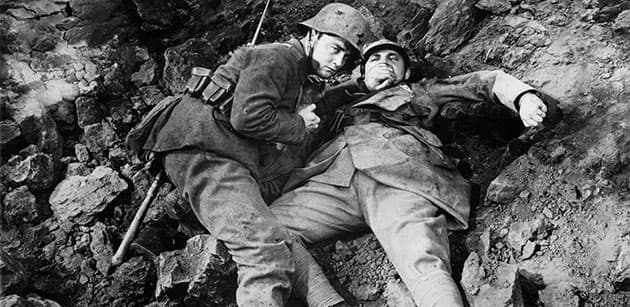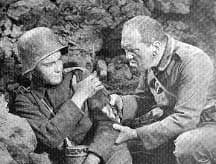All Quiet on the Western Front
Critique • Quotes • At the movies
 First American edition, 1929
First American edition, 1929First publication
1929
Literature form
Novel
Original title
Im Westen nichts Neues
Genre
Literary, war novel
Writing language
German
Author's country
Germany
Length
Approx. 67,000 words
Translations into English1929 by A. W. Wheen, 1993 by Brian Murdoch

Lew Ayres stars as the disillusioned soldier in classic 1930 film ofAll Quiet on the Western Front.
Classic anti-war film
All Quiet on the Western Front (1930): Film, 133–152 minutes,; director Lewis Milestone; writer Maxwell Anderson; featuring Lew Ayres, Louis Wolheim, John Wray, Arnold Lucy, Ben Alexander
The novel acclaimed as one of the greatest anti-war books ever published is sure to have been adapted for several movies. In fact, it's surprising more adaptations have not been made over the past century—though, to be fair, the book's somewhat depressing outlook may not be thought crowd-pleasing material.
Four movies have been made of All Quiet on the Western Front. The three you are most likely to find are the 1930 black-and-white classic, the 1979 made-for-TV movie, and the recent 2022 version made for Netflix. All are pretty good.
Which is quite an achievement, given the requirement that, on some level, movies entertain the masses.
The great one
One of the three productions of All Quiet on the Western Front is even considered an all-time great. The 1930 film won wide acclaim for its anti-war portrayal of the First World War, as well as Academy Awards for best film and director.
It also caused great controversy, perhaps being the only film both boycotted by the American Legion and banned by the German Nazis.
It's often called the greatest war film ever made.
This may be hard to understand though when you watch the actual film. Critics may be unduly influenced by its historical significance as the first important war film to be made after the talkies were introduced. By today's standards the movie does not hold up nearly as well as the book. It's melodramatic, badly paced and overacted.
This is not to put down director Lewis Milestone or Lew Ayres as the disillusioned German soldier Paul Baumer, or any others associated with the film. This is just how early Hollywood films were made. Three years after the first talkies appeared, All Quiet still seems like a silent picture in many ways.
A very good one though. The visual storytelling is brilliant—from one of the initial scenes of troops marching past school windows flanking the jingoistic old teacher haranguing his young students to the last scene of the soldier's dead hand reaching for a butterfly.
Classroom scene in 1930's All Quiet on the Western Front.
Throughout, the use of shadow, the juxtaposition of odd images, and dramatic camera angles provides fodders for film-study classes.
Especially effective are the scenes of Baumer in the crater trying to save the French soldier he had just attempted to kill, the camaraderie he experiences with his fellow soldiers (especially with Katczinsky played memorably by Louis Wolheim), and his disorienting return to civilization which sends him running back to the front where paradoxically he feels most alive.
The heart-rending conclusion to the 1930 film is a change on the novel but in complete agreement with its spirit.
— Eric


